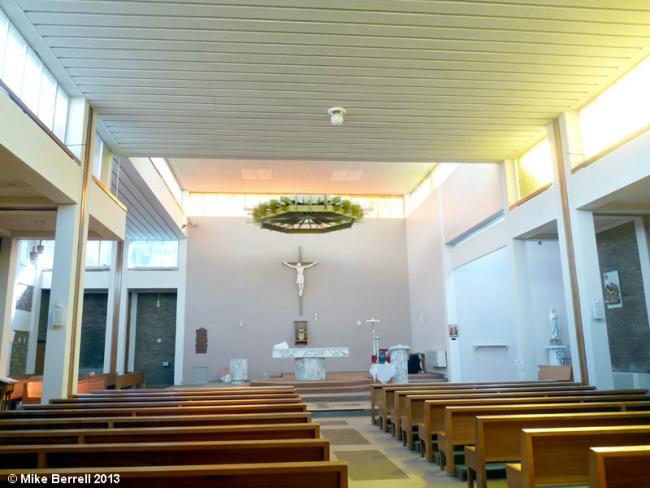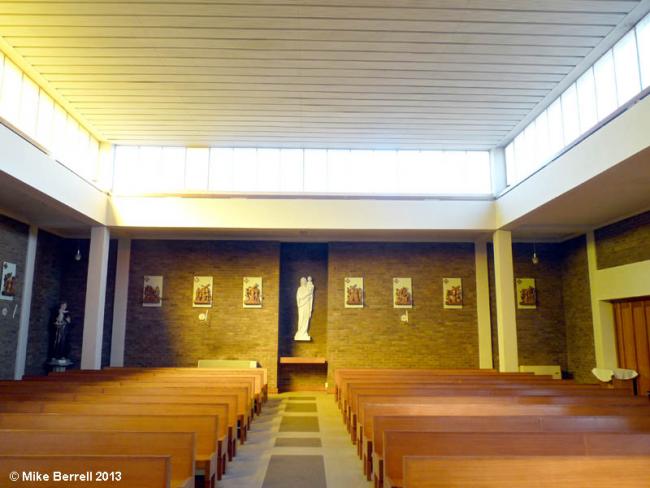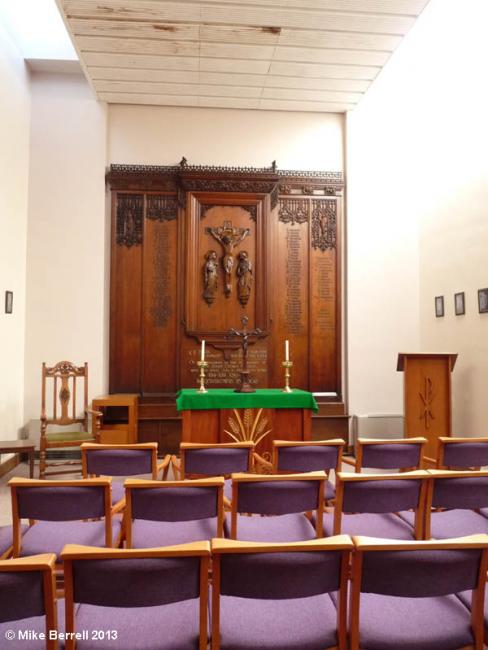Hide
St Mary of the Immaculate Conception, Swinton, Roman Catholic
hide
Hide
Hide
Hide
It was founded before in 1847 on Swinton Hall Road. In 1965 they moved to Park Sreet.
This mission began to have a separate existence about the year 1847. Before that time it formed a part of the Barton mission. In 1847 Father Hubbersty was sent by Bishop George Brown (V.A. of the Lancashire District) to look after the spiritual welfare of the few scattered Catholics that were in Swinton and Pendlebury and in the neighbourhood.In the year 1800 there was not a single Catholic to be found within the boundaries of the present St. Mary's. About the year 1812 a young couple, Sam Davies and his wife Betty, came to live here from Lowe House, near St. Helen's. He came to work for Knowles' Colliery at Little Moss Lane pit. They were the first Catholics to live here since the Reformation.
The failure of the potato crop in Ireland in the year 1847 brought a large Irish population to Swinton and Pendlebury. Father Hubbersty was sent to look after them. Of this priest I cannot learn any particulars. I believe he was Chaplain to the de Trafford family at Trafford Hall. I don't think he made much headway in Swinton.
In 1852 Fr. William Taylor was appointed by Bishop Turner to look after the Catholics of Halshaw Moor (near Farnworth) and Pendlebury. When he came to Pendlebury his flock consisted of 47 souls all told. The old census book was in existence until recently. He opened a mission room in Engine Brow - the place is in existence now and a poor place it looks. Many a tale is told - some amusing, some sad - of the way this priest and his flock were treated or rather persecuted by the natives. How some ignorant but conceited yokel would crawl noiselessly up the steps that led to the mission room, take a surreptitious peep at them while they were attending at Mass or Benediction and then hurry back to his pals and tell them with surprise "Why they are gradely folk after all." Epithets like "quack" and "red-neck" were freely t hrown at them - why this latter I do not know.
For four years from 1852 to 1856 they continued in joy and in sorrow with many tribulations and with many consolations to worship together in Engine Row.
In 1856 Mr. Daniel Lee came to live at Springfield House, Pendlebury. The house was pulled down last year [1899] - it lay off Butcher Brow. He was an Irishman and a good Catholic. He acquired a good deal of money in the Manchester cloth business. Father Taylor and Mr. Lee put their heads together and bought the piece of land and the cottage in Jane Lane which was just abandoned by the Unitarians. On that piece of land the present church, house, and school are built. The cottage is still standing [1899] - it is used now as a plumber's shop. It was to this cottage in Jane Lane - it is now Swinton Hall Road - that poor Fr. Taylor and his flock removed their altar from the humbler upper room in Engine Brow.
Mr. Lee made a gift to the parish of the site on which the present church, house, and school stand. The site being secured, Fr. Taylor now addressed himself to the onerous task of erecting a church. He was his own architect. He took Christ Church, Pendlebury, as his model. It took three years to build it. It was built "out of debt" and was opened on August 14, 1859.
After the completion of the church Fr. Taylor gave all his time to the Halshaw Moor or Farnworth portion of his work. He died at St. Mary's, Bolton, December 8, 1878, and was buried at Moston Cemetery, R.I.P.
He was succeeded at Swinton by the Rev. Fr. Peter de Blon, a native of Belgium in March 1860. Father de Blon was here during the Cotton Famine. He is often kindly mentioned by some of the older people of the place, both Catholic and Protestant. There are one or two of his converts in the place still. He broke down in health in November 1866 and died in 1867 abroad. It was during his time that Mr. Lee, at the cost of about £1,000, had the tower erected and the bell fixed.
After Father de Blon left there was an interregnum but the mission was served by Father Alphonse J. Sabbe. Father James Hayes (afterwards Canon Hayes) was the next Rector of Swinton. He was appointed about the beginning of January 1867. Fr. Hayes was born at Wigan, educated at Ushaw and was curate to Canon Sheehan (afterwards Rt. Rev. Monsignor Sheehan) at St. Chad's, Manchester. He erected the present presbytery, St. Mary's Mixed School and the Sacred Heart Chapel. The presbytery was built in 1870, the school in 1871. Until the school was built, the little cottage - formerly the Unitarian Chapel and now a plumber's shop - was used as a school. Miss Henshaw was the teacher. When Fr. Hayes left here in 1877, September 16, the liabilities in the way of debt due on the buildings stood at £848.
The next priest at Swinton was the Rev. Charles Walter Wood. In fact Father Wood and Father Hayes practically changed places. Father Wood came from St. Bede's, Manchester, to Swinton - he was Rector of that infant college and baby mission. And Father Hayes went to St. Bede's as Rector of the mission and vice-Rector of the college. Father Wood was born in Manchester and when a boy of about 13 years was received by Canon Toole of St. Wilfrid's, Hulme, into the Church. He was educated at Ushaw and Rome. He came to Swinton in September 1877. In 1881 he built St. Joseph's School, Pendlebury (the Lee Memorial School, he called it).
In 1885 he built St. Charles's School, Moorside, and in the same year he built the Infant School here at St. Mary's. He left Swinton for SS. Peter and Paul's, Bolton, in February 1892. Father Andrew O'Rourke was the next Rector, a learned Greek scholar and a wit. He was noted for his great sanctity and endeared himself to the people during his 34 years here by his sympathy and charity. A visitor to his house found it stacked with books of learning, a form of decoration no doubt copied from Canon Toole of St. Wilfrid's, with whom he had lived. After him, the parish has been governed by Fr. Weatherall, a convert, and Father Michael Cronin, a member of the Diocesan Board of Administration.
(Most of the above from Fr. O'Rourke's Log Book.) RED NECKS
The Swinton log-book seems to give the earliest instance recorded of the name Red Neck as an insult to Catholics. The great Oxford Dictionary in the many pages that it devotes to the word red mentions Red Neck as the name of a beetle and also quotes from an article in the Westminster Gazette (1900) stating that in Lancashire the Roman Catholics were called Red Necks.
No doubt there are many people in Lancashire who have never heard the words used, but in places where the Catholic body is strong, as around Preston and Wigan, the words are well known to both Protestants and Catholics. Some Catholics even use the words jocularly as a code word meaning R.C.
The same description has been found in Derby, where a Catholic Dramatic Society calls itself Red Necks. It is possible that the name was transported to Derby by textile-workers from Lancashire.
What is the origin of the name? What do the words really mean? Are they like the name Red Necks given to British soldiers by the Boers due to skin colour? In South Africa when the fair-skinned English soldier developed a sun-tanned neck the name was appropriate.
Some people have suggested that the name meant a criminal who should have a rope round his neck, as indeed so many of the Martyrs wore such a rope. It is hard to see that it could be a corrupted form of some other expression such as "Recusant", which was the official name for Catholics, or "Renegade."
Curiously enough, one of the descriptions used for Catholics in the seventeenth century was "Red Letter Men" - a reference to the calendar of Church festivals when the feast days were printed with red-lettering. That shows an early application of the word Red to Catholics, but there is no reference to a neck.
Mr. Kevin May of Bury, after discussing this question with his father, sent in some useful comments and suggestions about Red Necks. The present writer is inclined to accept his idea, until some proof is found that the name is more than 150 years old. Here is Mr. May's explanation:
"Around our district a Catholic working-man is often given the contemptuous name of a Mick or a Paddy, even if he is not born an Irishman, but because of his belief in the true Christian faith. The term Hard Gobs also applies, particularly in the building trade. It could be the same with Red Necks. Why? Because lots of really good Catholic Irishmen, the farming type, came out of the 'old country' with the distinctive mark of a red neck."
The Hard Gob is easy to explain. Often in a group of working-men sitting around the cabin fire on a building site at a lunch-time break, the conversation would turn to some subject which was against the Catholic man's principles. If he was a staunch follower of his creed, he would tell the other men what his position was as regards their conversation. Hence the term given to him in contempt by his fellow-workers, meaning that a Catholic or an Irishman could usually be distinguished by the set of his jaw, when the cruder subjects were discussed.
"In Lancashire it is also well known that lots of Irish come over for the summer season. The haymakers are sometimes termed contemptuously 'The July Barbers'. Maybe that has something to do with the Red Necks."
A suggestion from Preston was to the effect that Catholics used to blush when their enemies pointed them out in public. However, from what we know about Catholics in the days of persecution, they probably did more to make their opponents blush, rather than blush themselves.
A Mr. Fallon of Blackley informs me of two other strange passwords for R.C. used among some Catholics - "Left-footer" and "Duck Egg," the latter being more or less a reference to Irish eggs, he thinks.
Taken from "Salford Diocese and its Catholic past", a survey by Charles A. Bolton, a Priest of the above Diocese. Published 1950 on the First Centenary for the Diocese of Salford.
The original church on Swinton Hall Road was located
This site provides historical information about churches, other places of worship and cemeteries. It has no connection with the churches etc. themselves. For current information you should contact them directly.
Copies of Original Registers
Baptisms
- 1860-1941 held by Lancashire Record Office MF 1/286-287 - Microfilm
- 1860-1941 held by Lancashire Record Office MF 1/286-287 - Microfilm
- 1947-1962 held by Lancashire Record Office RCSF 2
- 1947-1962 held by Lancashire Record Office RCSF 2
Marriages
- 1867-1941 held by Lancashire Record Office MF 1/286-287 - Microfilm
- 1867-1941 held by Lancashire Record Office MF 1/286-287 - Microfilm
- 1947-1954 held by Lancashire Record Office RCSF 2
- 1947-1954 held by Lancashire Record Office RCSF 2
- 1961-1962 held by Lancashire Record Office RCSF 2
- 1961-1962 held by Lancashire Record Office RCSF 2
Baptisms
1860-1941
1947-1962
Marriages
1867-1941
1947-1954
1961-1962
- OpenStreetMap
- Google Maps
- StreetMap (Current Ordnance Survey maps)
- Bing (was Multimap)
- Old Maps Online
- National Library of Scotland (Old Ordnance Survey maps)
- Vision of Britain (Click "Historical units & statistics" for administrative areas.)
- English Jurisdictions in 1851 (Unfortunately the LDS have removed the facility to enable us to specify a starting location, you will need to search yourself on their map.)
- Magic (Geographic information) (Click + on map if it doesn't show)
- GeoHack (Links to on-line maps and location specific services.)
- OpenStreetMap
- Google Maps
- StreetMap (Current Ordnance Survey maps)
- Bing (was Multimap)
- Old Maps Online
- National Library of Scotland (Old Ordnance Survey maps)
- Vision of Britain (Click "Historical units & statistics" for administrative areas.)
- English Jurisdictions in 1851 (Unfortunately the LDS have removed the facility to enable us to specify a starting location, you will need to search yourself on their map.)
- Magic (Geographic information) (Click + on map if it doesn't show)
- GeoHack (Links to on-line maps and location specific services.)




